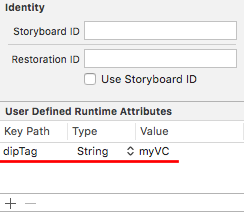Dip-UI is a part of Dip since version 7.0.0. Thir repository will no longer be maintained.
Dip-UI is an extension for Dip that provides support for dependency injection using Dip in applications that utilize storyboards and nib files.
You can install Dip-UI using your favorite dependency manager:
CocoaPods: pod "Dip-UI"
You need at least 1.1.0.rc.2 version of CocoaPods.
Carthage: github "AliSoftware/Dip-UI"
Dip-UI provides a unified and simple pattern to resolve dependencies of view controllers (or any other NSObject's) created by storyboards.
Let's say you want to use Dip to inject dependencies in MyViewController class defined like this:
class MyViewController: UIViewController {
var logger: Logger?
var tracker: Tracker?
var router: Router?
var presenter: MyViewControllerPresenter?
var service: MyViewControllerService?
/*...*/
}Note 1: Though constructor injection is a preferred way to inject dependencies, in this case we can not use it - we can not make storyboards to use custom constructor. We could do it using subclass of UI(NS)Storyboard and method-swizzling, but you don't expect such things in a Swift framework.
Note 2: Implicitly unwrapped optionals are used here to indicate that these dependencies are required for this class. You don't have to follow this pattern and are free to use plain optionals if you prefer.
To inject dependencies in this view controller when it is instantiated from storyboard you need to follow next steps:
- Register the dependencies in the
DependencyContainer, as well asMyViewController:
import DipUI
@UIApplicationMain
class AppDelegate: UIResponder, UIApplicationDelegate {
let container = DependencyContainer { container in
container.register(.singleton) { LoggerImp() as Logger }
container.register(.singleton) { TrackerImp() as Tracker }
container.register(.singleton) { RouterImp() as Router }
container.register { MyViewControllerPresenterImp() as MyViewControllerPresenter }
container.register { MyViewControllerServiceImp() as MyViewControllerService }
container.register(storyboardType: MyViewController.self, tag: "myVC")
.resolvingProperties { container, controller in
controller.logger = try container.resolve() as Logger
controller.tracker = try container.resolve() as Tracker
controller.router = try container.resolve() as Router
controller.presenter = try container.resolve() as MyViewControllerPresenter
controller.service = try container.resolve() as MyViewControllerService
}
DependencyContainer.uiContainers = [container]
}
}Note: All the depdencies are registered as implementations of abstractions (protocols).
MyViewControlleris registered as concrete type. To register your view controller as a protocol read here.
- Set the container as one that will be used to inject dependencies in objects created by storyboards. You do it by setting static
uiContainersproperty ofDependencyContainerclass:
DependencyContainer.uiContainers = [container]- Make your view controller class conform to
StoryboardInstantiatableprotocol:
extension MyViewController: StoryboardInstantiatable { }Tip: Do that in the Composition Root to avoid coupling your view controller's code with Dip.
- In a storyboard (or in a nib file) set Dip Tag attribute on your view controller. This value will be used to lookup definition for view controller, so it should be the same value that you used to register view controller in the container.
Note: remember that
DependencyContainerfallbacks to not-tagged definition if it does not find tagged definition, so you may register your view controller without tag, but you still need to set it in a storyboard. In this case you can useNilattribute type instead ofString.
Now when view controller will be loaded from a storyboard Dip-UI will intercept the setter of dipTag property and will ask DependencyContainer.uiContainer to resolve its dependencies.
StoryboardInstantiatable protocol defines single method didInstantiateFromStoryboard(_:tag:) and provides its default implementation. In most cases you will not need to override it. But if you register your view controller as an impementation of some protocol instead of concrete type, or want to perform some pre/post actions, you will need to override it like this:
container.register { MyViewController() as MyScene }
extension MyViewController: StoryboardInstantiatable {
func didInstantiateFromStoryboard(container: DependencyContainer, tag: DependencyContainer.Tag?) throws {
try container.resolveDependenciesOf(self as MyScene, tag: tag)
}
}Dip-UI is available under the MIT license. See the LICENSE file for more info.





